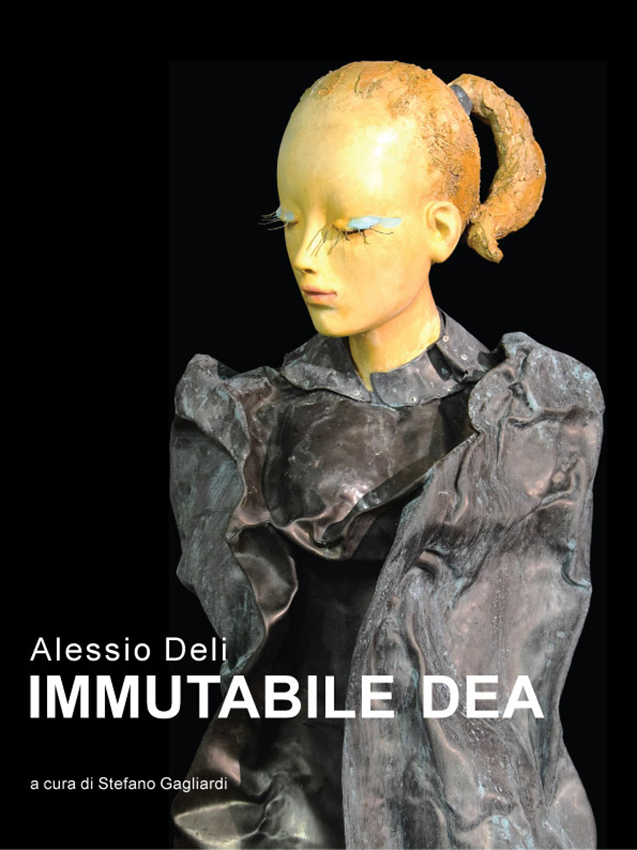 IMMUTABILE DEA
IMMUTABILE DEA
Interview by Stefano Gagliardi with Alessio Deli.
What does being an artist, here and not elsewhere, mean to you today?
Not long ago, during one of my shows in Rome, a visitor who actually lived in the city (one of very few compared to the numerous tourists who fill the capital’s museums and exhibitions every day) burst, somewhat sweaty, into the deconsecrated church where the exhibition was being held, and, at the end of the visit, asked “are you the artist?” and obviously I answered “yes!”. After a few seconds, the unknown visitor shook my hand warmly and said “ehm, thank you then! You gave me ten minutes’ breathing space today, and I really needed it”. Needed what? Probably beauty, probably inspiration for some kind of reflection... or even just a breath of fresh air... Substantially, I think that, in the light of this little anecdote, artists today are invited to generate a sort of re-education to appreciate beauty, because people are no longer used to beautiful things.
Your sculptures often touch on a constant female figure, almost a silent and unchanging muse: what hidden links are there between you and this Goddess?
Let’s return to the subject of beauty... Our beauty... The beauty of the Mediterranean. We are lucky enough to be surrounded by beautiful nature. Unique and powerful. Present everywhere in art, architecture and music, and in what we eat and drink. A Mediterranean DNA, present in our veins since the dawn of time, which is inevitably a bit Greek, a bit Egyptian and a bit Balkan, with Syrian, Etruscan and Roman influences... A facial feature, the shape of a nose, a hair colour, a particular eye shape. An idealised yet real, living physiognomy. An unchanging Goddess.
Your latest sculptures, while continuing to be linked to the choice of poor materials, seem to be increasingly detached from the use of recycled materials: is this the start of a new cycle?
For over ten years, my artistic research has been based on the combination of plastic elements linked to classicism with unconventional materials, otherwise destined to be thrown away, such as metal sheets, iron, plastics, etc. The construction of these sculpted figures marked the beginning of a clearly defined “stylistic identity” for me in the contemporary artistic panorama, a language which has been rewarded and appreciated in time by both public and private collections. This said, my training took place with the use of traditional materials, among the marble quarries of the Apuan Alps and the artistic foundries of Versilia. Reflecting well on this question, I think that, especially in the beginning, I wanted to express an ideal of contemporary figuration which, as a prerequisite, could only exist through experimentation with and the use of innovative materials; now, on the other hand, I can say that it is more the achievement of a form that makes a figurative sculpture contemporary, and this occurs only as a result of experience and the constant observation of nature, without any executive restriction, therefore it is not dictated by the material we decide to use.
You are an artist who creates sculptures and installations that are well introduced into the language of contemporary art but you often sustain your link with classicism. In what terms?
Classicism or antique have always been a source of inspiration for every type of artistic exercise. The “ancient populations”, especially those of certain particular and remarkable periods, were perhaps more interested than us and more constant in their careful observation of nature (as mentioned in the previous question), extracting wonderful things and common sense from it, such as proportion, rhythm, colour, shape, balance, contrast, etc... Paradoxically, I feel that the closer we approach an “antique” modus operandi so as to speak, the more our work today becomes deeply contemporary.
How does Deli the painter coexist in your artistic production with Deli the sculptor?
I was a curious student of sculpture. Always peeking into the painting technique room, intent on jotting down recipes and proportions for preparations and colours. Painting is the work of an alchemist; it is fascinating. In the past, before sculpture took up all of my time, from teaching to studying, I used to paint a lot too. Today, the pictorial aspect linked to this youthful passion is used in my artistic production, partly for the four-colour works that I create using oxidisation and the acid treatment of metal sheets, but above all, I really gain satisfaction from and have fun with the conclusive part of my sculptures. Colouring and patina coating are the soul, the final touch and, consequently, the seal of my sculpture. In conclusion, we could say that this is something else that we have learned from the “ancient populations”; possibly not everyone knows that the beautiful marble statues (now as white as snow) of Greek gods and athletes were actually once covered in an array of colours!



